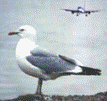Bird Strike Committee Proceedings

Bird Strike Committee-USA/Canada Joint Annual Meeting: 8th (2006)
Date of this Version
August 2006
Document Type
Article
Abstract
Ground-nesting birds like lapwings and sandpipers constitute a major hazard at airports. Preliminary observations with the Israeli Air Force showed that stone curlew (Burhinusoedicnemus, (Burhinidea)) were involved in 33% of all bird strikes in 2003 at Hatzor Air Force base in central Israel, most of which occurred during the nesting season. The ultimate reduction of curlew populations near the runways is dependent upon understanding the effect of predation risks on the curlew nesting behavior. In theory, true predation and artificial predation should have the same effect on bird behavior. We studied the effect of egg collection vs. egg collection complemented with “predation” by Border collies to determine if the harassment by the dogs resulted in a higher or faster rate of abandonment of nests on airfields, by placing the disappearance of a ground-nesting bird’s eggs into the context of predation. Harassment by Border collies on most other ground-nesting species actually avoids the entire problem associated by nesting on the airfield by quickly and effectively eliminating the presence of the ground-nesting species, precluding any nesting behavior in the first place. However, the limitations of the habitat of IAF airbases and the superb camouflaged nature of stone curlews result in the delayed discovery of nests on IAF airfields. The limitation a female curlew has on the number of eggs it can lay each season may ultimately have two contradictory results on nest abandonment. If the amount of eggs is small and fixed, harassment with dogs coupled with egg removal would be expected to yield a shorter nesting season. On the other hand, if the amount of eggs is high, harassment might actually increase the total number of clutches per nesting pair and prolong the nesting season (and hence the time spent on the airfield). We discovered that the amount of eggs female curlews can lay in a season is at least twice higher than reported in literature and varies tremendously between individuals. Nevertheless, harassed curlews abandoned nests at significantly higher rates compared with curlews that lost eggs by strict removal.

